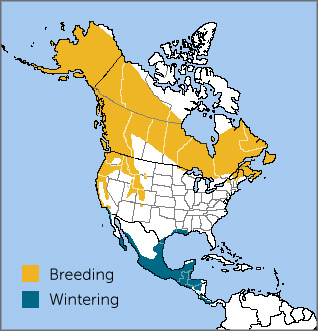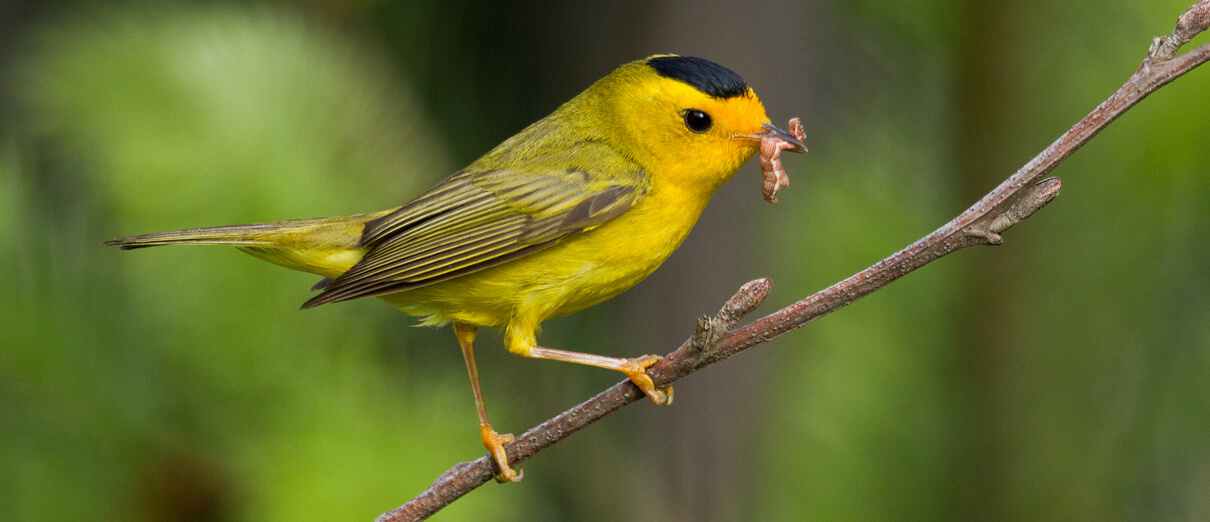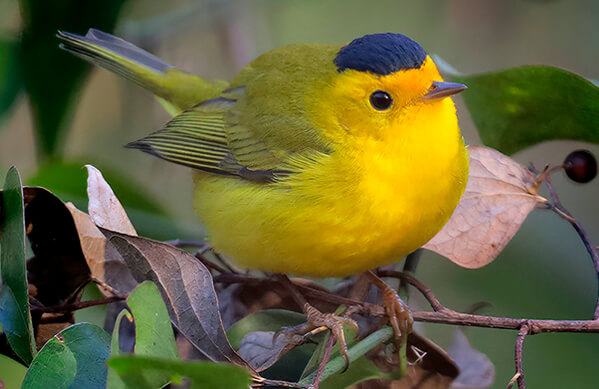
Wilson's Warbler range map by NatureServe
The small, sprightly Wilson's Warbler is seemingly always in motion, flicking its wings and waggling its tail up and down and in circles. Aside from its ceaseless activity, this little warbler can also be told by its bright yellow underside and face, set off by an olive-green back and wings. In addition, the male Wilson's has a jet-black cap resembling a beret.
Its genus name Cardellina is an Italian diminutive of cardella, which means "goldfinch," referring to the warbler's eye-catching yellow color, which may fool some viewers into identifying it as an American Goldfinch. Its species name pusilla means tiny — at 4.5 inches long, it's one of the smallest North American warblers.
The Wilson's Warbler was first described in 1811 by the American ornithologist Alexander Wilson, after whom the Wilson's Plover and Wilson's Snipe, among others, are also named.
Black-capped Warbler
The Wilson's Warbler could also be called the "Thicket Warbler” because it nests mostly in low, dense stands of willows, alders, and other trees and shrubs, like the Yellow Warbler and Orange-crowned Warbler. Of course, with the male's diagnostic beret, the species could be re-named the “Black-capped Warbler” as well.
It's no coincidence that the three species named above have breeding ranges extending farther north than those of most other warblers. Their affinity for open nesting habitats enable these birds to breed across most of Canada and Alaska, north into the stunted transition zone between boreal forest and tundra.
Wide-ranging Warbler
In the case of the Wilson's Warbler, this canary-yellow songbird breeds from Alaska's Aleutian Islands east to Canada's Atlantic provinces of Newfoundland and Nova Scotia. In the West, its range extends south through much of the Rocky Mountains and the Sierra Nevada, and down the West Coast to southern California (where some also winter).
A short- to medium-distance migrant, the Wilson's mostly winters in Mexico and Central America, but some ride out the cold months in the United States along the Gulf Coast in Louisiana and Texas, as well as in southern California. On tropical wintering grounds, Wilson's Warblers are among many Neotropical migrant species, including Blackburnian Warbler and Wood Thrush, found mingling with resident birds in insect-rich shade-coffee plantations. There, they frequent not only the tall shade trees but also, at times, the coffee plants themselves.
Three subspecies of Wilson's Warbler are currently recognized, based on plumage color, cap size, and body size. Western birds show the brightest yellow plumage. Interestingly, eastern and western breeding populations have diverged genetically and may eventually be recognized as separate species, although the Interior West population has characteristics intermediate between the two.
The Wilson's Warbler's lively song is a rapid series of chattering notes, often descending a bit at the end. It also has a distinctive sharp chip or zip call familiar to birders regularly encountering this at-times skulking bird. On wintering grounds, this call is the best way to locate the species by voice.
(Audio: Wilson's Warbler song by Rick Sharloch, XC511436. Accessible at www.xeno-canto.org/511436. Wilson's Warbler call by Peter Boesman, XC322975. Accessible at www.xeno-canto.org/322975.)
Invertebrate Hunter
Like most wood-warblers, the Wilson's Warbler is insectivorous. It feeds on adult and larval insects, including leafhoppers, bees, mayflies, beetles, and caterpillars, as well as spiders. It occasionally eats berries, particularly during the winter.
The Wilson's Warbler is an active forager, gleaning high and low among leafy vegetation, hovering to pluck prey from the outer branches of a tree or shrub, or dashing out from a perch like a tiny Willow Flycatcher to seize an insect from the air.

Male Wilson's Warbler, by Robert L. Kothenbeutel/Shutterstock
Mostly Monogamous
The Wilson's Warbler is seasonally monogamous, although polygyny (when a male mates with more than one female) may be fairly common in mountain populations. In good habitat, this warbler can be found nesting in loose groups with overlapping territories.
The female Wilson's Warbler usually builds her cup-shaped nest of leaves, moss, and rootlets on the ground at the base of a shrub or small tree, concealed by dense vegetation. The Pacific coast population is an exception, usually nesting several feet above the ground amid thick tangles of vines or shrubbery.
The female lays a clutch of four to six eggs and does most of the incubation. Both parents feed the young, which fledge when they are about 10 days old. Western populations of the Wilson's Warbler are commonly parasitized by the Brown-headed Cowbird.
Conserving a Common Species
Although still common, the Wilson's Warbler has experienced widespread population declines, particularly in the West, primarily due to loss of riparian habitat.
Partners in Flight rates the Wilson's as a Common Species in Steep Decline, along with the Common Grackle, Northern Bobwhite, Cactus Wren, and others.
The Wilson's Warbler also faces threats from pesticides (particularly herbicides used to clear brush) and is often a victim of collisions with man-made structures.
ABC's BirdScapes approach helps conserve the Wilson's Warbler and other migratory birds across their full annual life-cycle. ABC also has several initiatives in place to tackle threats. These include our Collisions program, which offers multiple solutions to pervasive challenges faced by birds transiting our built-up landscapes.
Donate today to help us save Wilson's Warblers and their habitats throughout the Americas!



















































